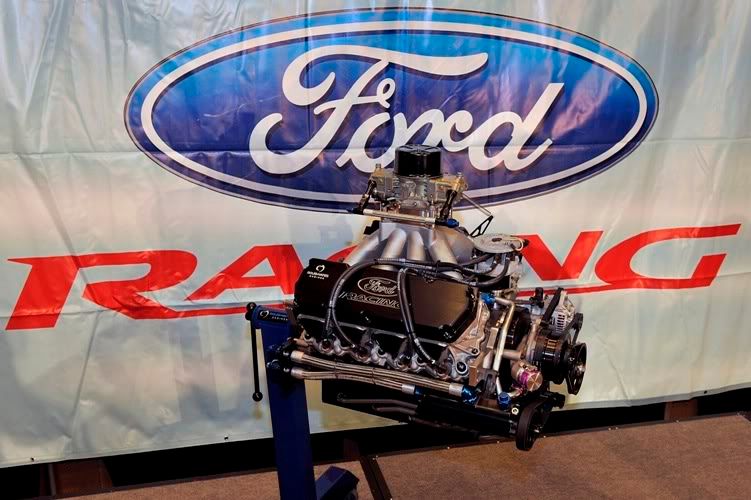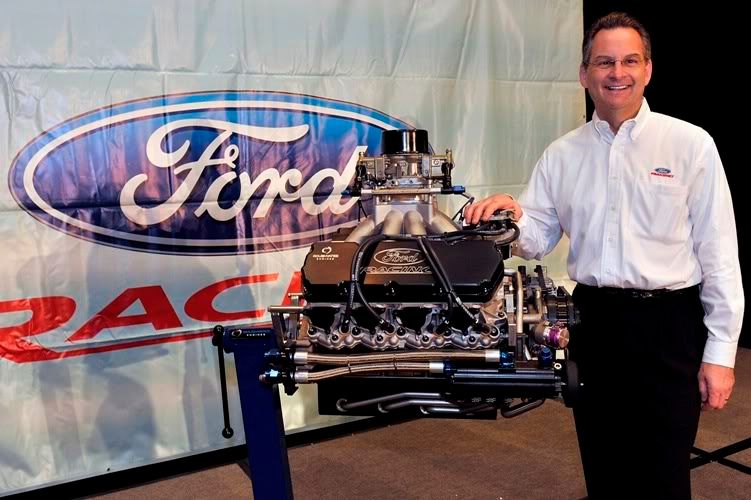Ford has unveiled to the public a new motor designed strictly for NASCAR racing, motivated by the need to keep up with Toyota. Like Toyota's motor, this is a clean sheet motor, not based on an earlier design or on a production motor, it is strictly a race only motor optimized for racing at 8000 rpm; not optimized for mass production, low rpm, emissions, fuel economy or to last more than 100,000 miles in the hands of neglectful owners.
It is called the FR9


FR9 engine specs
Feature..........Value
Layout.............90-degree V8
Displacement...358 cid (5.87L)
Valvetrain.........2 valves/cylinder, pushrod
Induction..........Naturally aspirated, single 830 cfm carburetor
Bore Spacing....4.500"
Camshaft Ht.....6.150"
Main bearings....5, plain
Camshaft brgs..6, 60mm roller
Deck Height......9.000"
Comp ratio.......12.0:1
Fuel..................Gasoline
Block Material...Compacted Graphite Iron
Head Material....Aluminum
PRESS RELEASE
Ford Racing and Roush Yates Engines will debut the new “FR9” engine during the 2009 NASCAR Sprint Cup Series season.
DEARBORN, Mich., January 22, 2009 – Ford and Roush Yates Engines already enjoy a reputation for producing some of the best power and reliability in the sport, but its latest NASCAR-approved engine has raised expectations to an even higher level for 2009.
Code-named “FR9,” this new piece is the first purpose-built NASCAR racing engine to ever come out of Ford Motor Company. Its design has been spearheaded and developed by Ford Racing engineer David Simon, and famed engine builder Doug Yates, along with input from legendary Ford Racing engine engineer Mose Nowland.
“This is an exciting time for us to say the least, especially with the way our two companies have worked so well together on this project,” said Yates. “I’ve never had the opportunity to work on a NASCAR engine with a clean sheet of paper, but that’s basically what we’ve done and I’ve enjoyed every second. We feel we’ve got a piece that will not only be better than what we’ve got now, but will give us room to grow.
“With the exception of a few cylinder head changes through the years, we’ve had the same engine since 1991 and have been able to squeeze out every ounce of power and speed possible,” continued Yates. “What’s got me so excited is we’ve won races and championships with an engine many consider old, and this new piece is definitely a notch above, so we’ve got a lot to look forward to for years to come.”
There are three key differences between “FR9” and the current engine. First, the cooling system has been re-worked and will allow teams to optimize the amount of tape they can put on the front grille and improve downforce. Second, the valve train has been improved, and, third, the production and assembly of “FR9” will be much easier than today’s model.
Another thing is for certain, this isn’t your father’s 351 because “FR9” does not retain any of the original production 351 dimensions as the current model.
“Our main priority when we started this project was to get the bones of the engine right. We wanted to make sure we had the proper layout, the right block structure and that the overall skeleton of the engine was correct,” said Simon. “Even though we’ve been working on these engines for decades and know a lot of things about them, there was still a lot we didn’t know. In that case, we went and did some testing to get the answer.”
That data driven philosophy for designing the engine was crucial for building an engine that would not only be reliable and efficient, but powerful as well.
“It was a completely different mindset and approach to making power,” recalled Simon. “We did not finalize any part of the engine until we acquired the data that told us what was going to be our optimum setting or optimum dimension. The key to all of this in the first phase of our development was to produce as much power through the design of the engine as possible and to make sure we had the very best layout, the very best dimension, and the very best combination of dimensions that we could within the framework of the rules.”
Since taking over as Ford Director of North America Motorsports in August, Brian Wolfe has had to learn a lot in a short amount of time, but he’s been impressed with how well “FR9” has developed.
“Before taking over this job, I worked in powertrain development at Ford for 26 years, and it’s always great to see a new product,” said Wolfe. “To see the way everyone has worked together on this project is extremely gratifying and I know when “FR9” is ready for the race track, we’re going to be spending a lot of time in Victory Lane.”
Just when “FR9” is ready for competition remains to be seen, but a tentative target date is the second-half of the 2009 season.
“We’re not going to rush this engine into competition until we’re 100 percent sure it’s going to meet our strict standards,” said Yates. “We don’t feel a need to rush because our current engine is still strong and that gives us the luxury to take our time and make sure we do “FR9” right. I know we’ve got a winner here, and I can’t wait to see it on the track."

